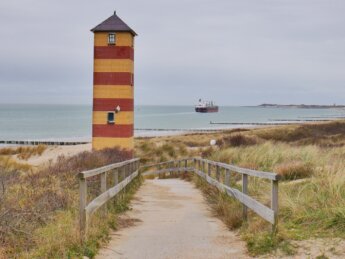
Events in this story happened on July 3rd, 2019. We paddled our inflatable canoe named Zucchini from a village called Kobling to the bigger town Aschach an der Donau in Austria. The total distance was 16.6 kilometers. We stayed in Aschach for two nights.
Want to travel the (entire) Danube River in an adventurous way? Join our Facebook group Danube River Source to Sea: Kayak / Canoe / Bike / Hike / Sail to find your community
Leaving Kobling for Aschach an der Donau
We only stayed in the hotel Idylle am Donauufer for one night. They only served breakfast at 8:00, so we slept in more than we’re used to by now. We ate our breakfast, chugged some hot coffee, and prepared two sandwiches for the voyage. Then we brush teeth, finish up packing, and bring our stuff to the shore.
Jonas still has that Backstreet Boys song As Long As You Love Me in his head. It’s been three whole days. He hums his earworm as we inflate the boat at 9:15, and I ask him if he could please, please, not make me catch it too. I don’t care whoo -youu – are…
By 9:40, we’re paddling on to Aschach. It’s only about 17 kilometers according to our spreadsheet, with one dam to portage around. This is one of the reasons we’re comfortable starting this late.


We directly cross the river from the right shore to the left. Goodbye cute ferry, hello sunny yet cool day.
Invasive Species
We’re paddling comfortably in the cool shadow on the left-hand shore. Today’s route is a little less bendy than the previous day. From the shadow of the trees, before the bend at a hill called Rad Gupf, I see something moving in the water. It’s a caterpillar floating in the water and contorting its body scarily. It’s a big caterpillar, about 7 centimeters in length. We paddle on.
Then at the next tree, I see another one in the water. And another one. All of them are alive and wiggling their way on the surface tension. I ask Jonas if he thinks it’s one of those invasive species of caterpillar – you know, the ones that cause severe allergic reactions in humans. I only know the Dutch name for them (Eikenprocessierups) and Jonas probably only knows the word in German. But we both know what we’re talking about because this particular bug has been dominating the summer news at least since my early teens.
I have to Google the English name and it’s the ‘Oak Processionary Moth/Caterpillar’. The first part sounds very reassuring, while the latter sounds quite threatening.
“Let’s stay away from them,” Jonas says. But I want to capture one on camera for further analysis.
We paddle on until we find another one floating in the water. We encircle the little bug by paddling our nearly 3 meter-long boat in a circle around it while I’m filming it. It’s astonishing how much control we’ve gained over the boat since clumsy day one.
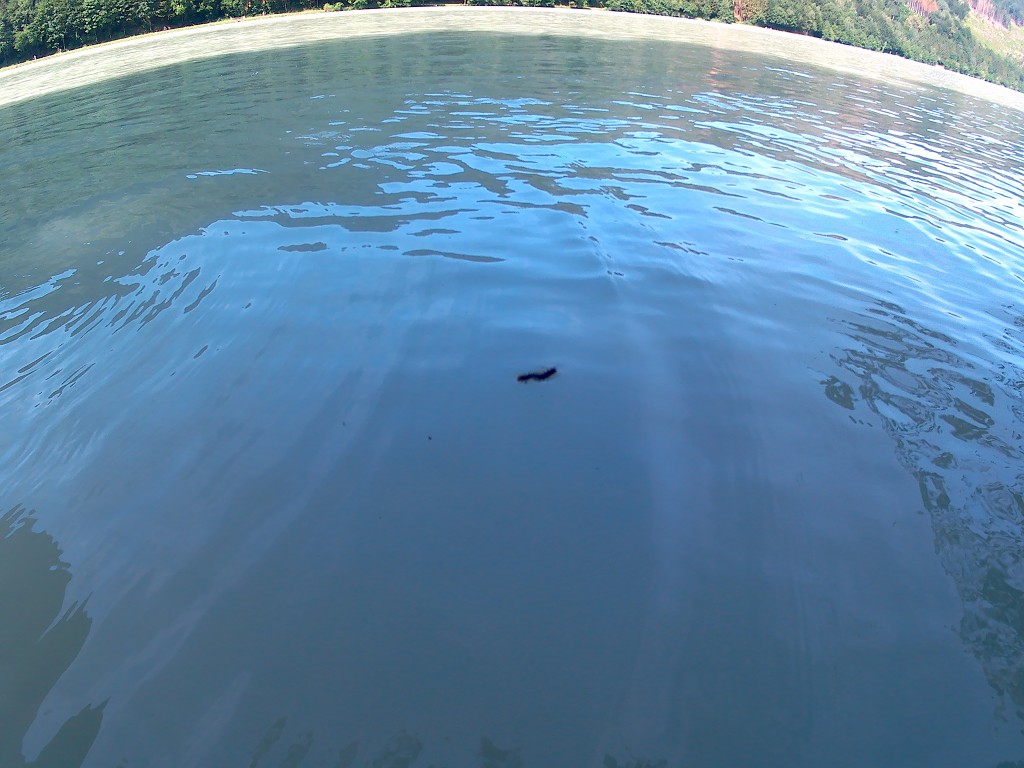
Now the real question is… what is the bug doing in the water? Is the riparian zone (i.e. biome around a river) an obstacle to overcome? Have they evolved to swim across and cause more havoc on the other side? Did their mad leader lead them off a tree in a mass suicide event? Are Jonas and I at risk here? Should we yeet them back to southern Europe, where they belong?
We don’t get any symptoms of having inhaled their urticating hairs, so we paddle on.
The Mühlviertel
We crossed back to the right side of the river at 11:00. After a few more kilometers and tiny bends, we spot Untermühl on the left-hand shore. The river Große Mühl enters the Danube here, and the day before we were at Obermühl, where the river Kleine Mühl enters the Danube. Both do so from the left.

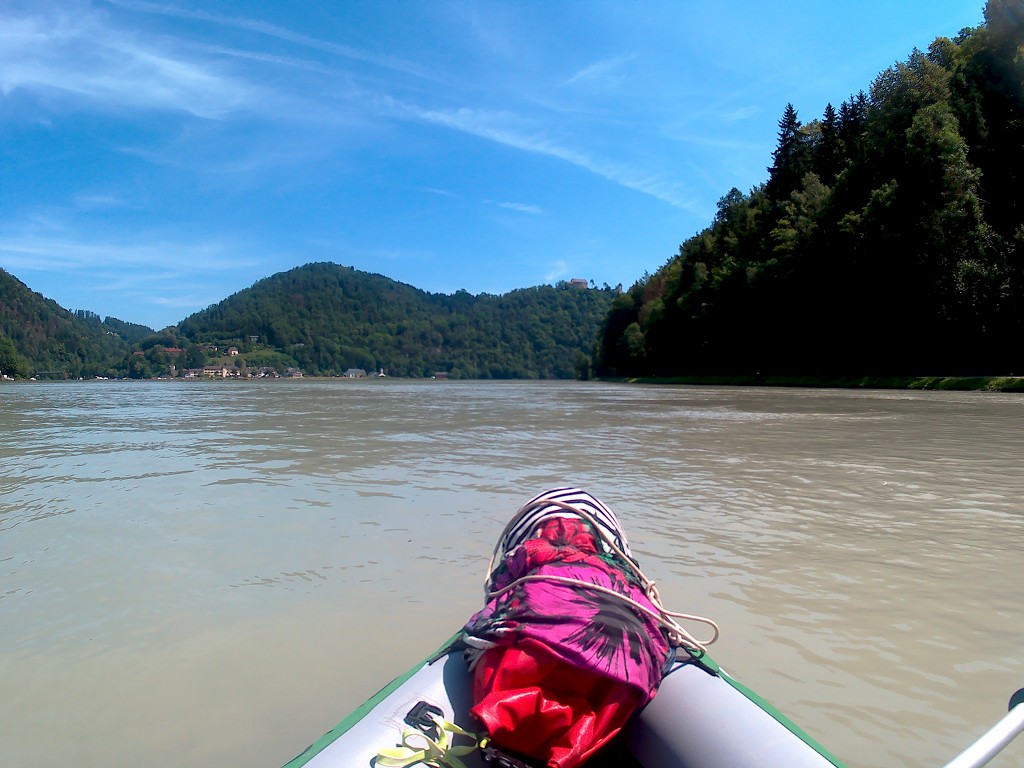
We’re currently traveling in the state of Oberösterreich (Upper Austria) of Austria. This state has been divided up in ‘quarters’, and the whole quarter north of the Danube – on our left hand – is called the Mühlviertel (Mill Quarter), named after these two tributary rivers.
It’s a very beautiful region, providing inspiration to musical compositions and other forms of art. But it has also been the site of a massacre towards the end of World War II on February 2nd, 1945. Some 500 Soviet prisoners in the nearby Mauthausen-Gusen concentration camp escaped. Nazi’s, soldiers, and civilians spent three weeks chasing them down and killing them all around the Mühlviertel in an operation called the Mühlviertler Hasenjagd (Mühlviertel rabbit hunt). A war crime. Only 11 escapees remained free and alive till the end of the war seven months later.
Schloss Neuhaus an der Donau
We paddle past one of the two ferries at Untermühl at 11:40 and approach a castle on a hill on the left-hand side of the shore. Jonas and I do our research before we paddle, but we don’t particularly look for landmarks before we go. We let ourselves be surprised by the beauty and history that entwines this splendid river. And also its exploitation, it’s pollution, and its subjugation to human desires to tame Earth.


So I look on my map to reveal the name of this castle. It’s the ‘Neuhaus an der Donau’ castle and it looks like a popular destination. I grab my good camera to take some photos from inside our canoe instead of the kind of shitty ones I take with my action cam. It’s funny how some part of it looks well-renovated and then the other half looks like they ran out of money.
The other ferry goes from Untermühl on the left-hand side, passing underneath the castle, to a dead-ended bike path also on the left-hand side. That’s because the shoreline here is quite steep and the Donauradweg (Danube bike path) ends temporarily. Luckily, these cyclists – whether day-tripper or long-distance cyclists – are very fond of these little ferries.
Danger Noodle
We stick to the right-hand side until the river bends more to the right and a sign appears to tell us that paddle boats need to switch sides. Then, at 12:05, we cross to the left – which is where we’ll have to be to portage our kayak around the dam named Kraftwerk (hydroelectric power plant) Aschach. And Aschach is our destination for the day. We share the river with a tiny duck that’s not too afraid of us. I really like ducks.


We sight the dam in the distance. It’s still a good 4 kilometers before we arrive at the exit point. The wind is coming slightly from the back, but the current has come to a halt. We decide to make a urinary relief break on the left-hand shore and land our boat at a full kilometer sign. We’re very cautious about cyclists here because the ferry travels to and fro these stretches of the bike path. If I’m unlucky, I’ll be disturbed mid-stream. The steepness of the surrounding areas and lack of secluded areas stresses me out a bit, but I persevere and so does Jonas without interruption.
When I return to our boat, I see something long and thin and like a noodle floating through the water.

“Snake!” I shout. Jonas comes to see what’s going on. “Look! It’s a swimming danger noodle!”
“Well, that cements my choice to never go swimming in this river,” he says. I show my full face of disappointment.
For science, I snap some pictures of little Charlene here in the water, who is just going around minding her own business. Thank you for being here, Charlene.

Aschach Hydroelectric Power Plant
We’re back in the water and paddling the last few kilometers to the dam. There are loads of fishermen and other people with cars and big-time equipment on our shore. We greet them as they drive in and out of the place. There’s a little marina here too, where people with tiny motorboats or Zillen moor their vessels at.
A Zille is a type of boat that’s native to the German and Austrian Danube. It’s a long wooden boat with a shallow draft that has been used on the Danube for a few centuries. The paddle day before, between Engelhartszell and Kobling, I’d spotted a boatmaker on the northern (left) shores of the Danube that advertised their craftsmanship in Zillen. They used to be propelled manually, but today they have an outboard motor to make life easier. One such boat overtook us as we were about to pass a moored cargo ship.
The cargo ship was a Hungarian ship called ‘Tokaj 3’. It was moored quite a bit off the shore because it was shallow around that area. There’s a big sign telling boat people that they’re allowed to squat a mooring spot for no more than 48 hours. We paddle around the boat on the right, hoping to dodge any ropes on the left. A man who is checking his cargo on board greets us as we paddle the last stretch to our exit spot.


We arrive at a pretty good pier with the option of a ramp at 13:10. We take the pier and get out. I’m quite warm and covet the sweet, sweet shade. There are no boat wagons in sight, so we decide to portage our boat without the mighty power of wheels by ourselves. I choose to carry the heavier load this time.


We’re halfway the portage in the shadow of the dam’s arches when a friendly cyclist – who has neither monkey nor circus in our paddling business – shouts in German that there are boat wagons twenty meters away from us. We drop the boat and check it out.
The man is right. A beautiful fenced-off area with three boat wagons awaited us. I guess we’re still traumatized by the lack of infrastructure in other places along the Danube, so we often don’t believe in the providence of the Austrian kayak/canoe/rowboat lobby. We should know better by now.


We lift our boat onto the wheels and start rolling it to the ramp on the other side of the dam. It would have still taken us at least three more stops without a boat wagon. The toughest part of carrying the boat around for me is on my hands, as it always feels that the space in between the bones in my hands get stretched out beyond their natural limit. Even while wearing gloves.
We drop the boat in the water again on the lower side of the dam. I attach the boat to the shore with the front and back ropes and the carabiners so Jonas can put our luggage back in while I return the boat wagon for other paddlers. While I bring the boat wagon back to its station and discover a sign with a website name about the Austrian dams. I snap a picture of it for future reference. And boy, I’m glad I did when I had the internet to check it out



When I returned to Jonas, the boat was already packed and ready. Three more kilometers to go.


Arrival in Aschach an der Donau
We stick to the left shore until we can see a little more into the lock section on the right-hand side of the river. We need to get out on the right-hand side of the Danube today for our accommodations in Aschach, but we don’t want to cross when a big ship is about to depart from the locks at full speed. When the coast is clear, we cross for the final time today and land our boat at 14:00.

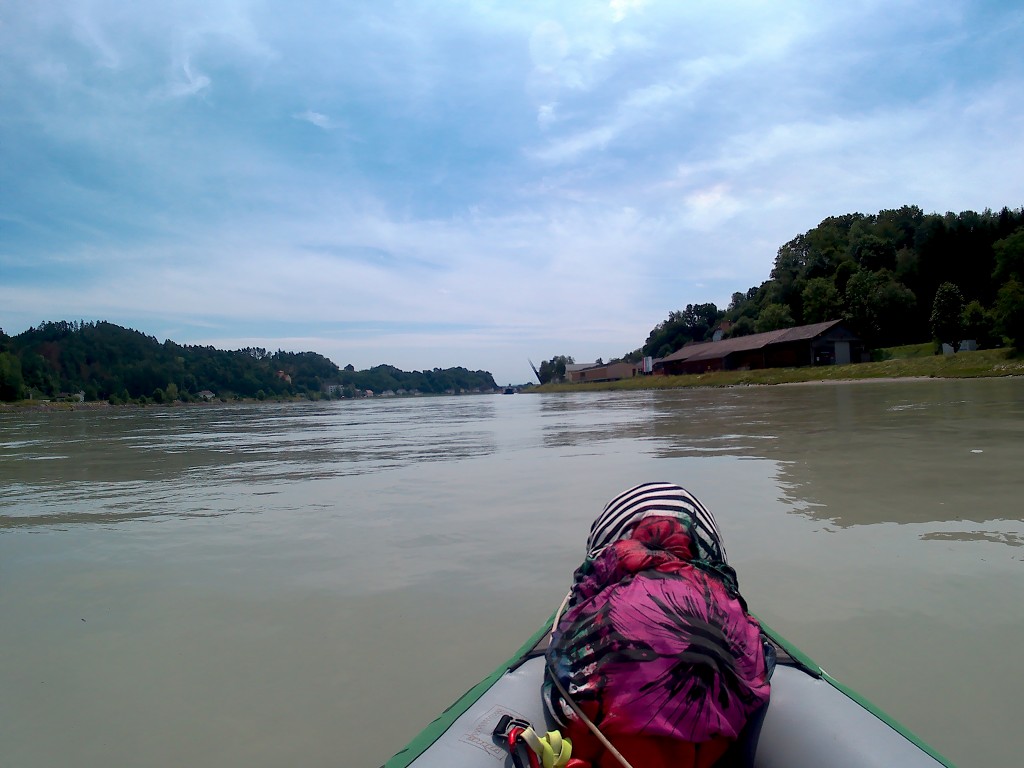

The area where we intend to land is surprisingly beachy. Some pebbly beaches allow us to land anywhere as long as we’re willing to deal with humans with young children feeding ducks their old bread. As we’d researched proper ramps in Aschach a few days earlier, we wanted to go where it seemed good. Right after the beach, there was a childfree ramp into the water that was just… perfect. Perfect because the big sign to a beer garden named ‘Aschacher Hof’ was right above it. This is going to be good.


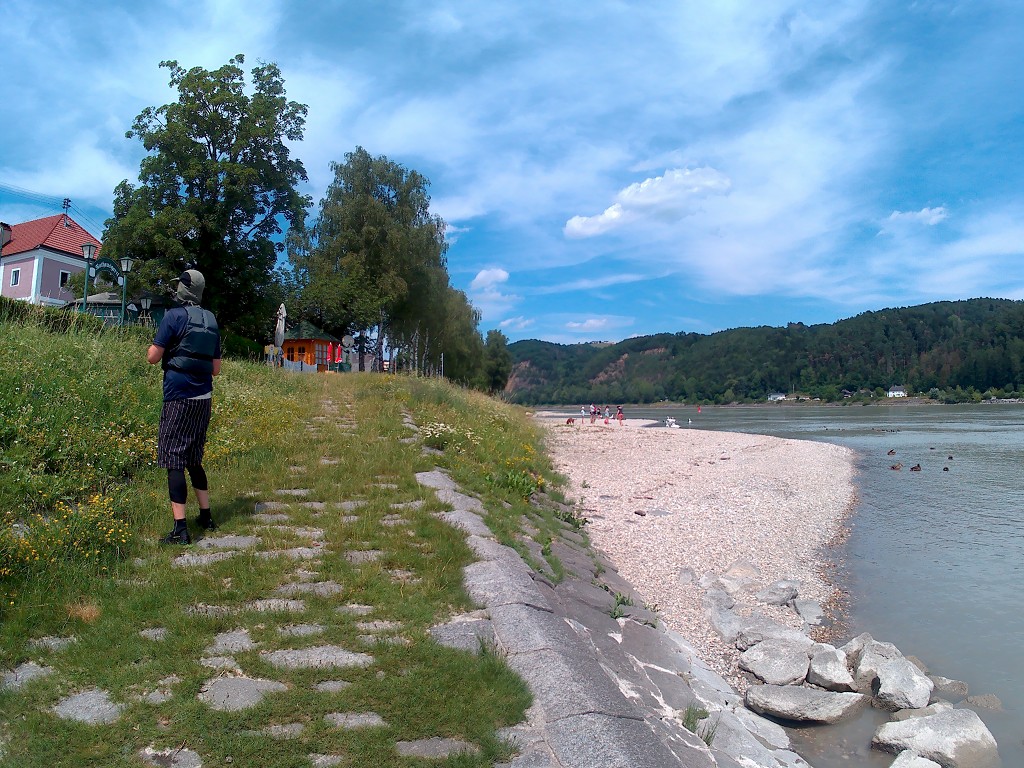

We landed our boat, moved everything up the embankment, and went into the beer garden to inquire whether it’s open. It was, so I quickly moved our stuff inside while Jonas prepped the boat for drying in the sunshine. Soon, we had two big wheat beers to enjoy and the knowledge that our boat would dry properly before we had to stow it away into the backpack. We were the only customers that hour.
Then we walked the 350 meters to our hotel named Josepa Hirsch, which is also a Thai restaurant. This is the most expensive hotel we’ve stayed at so far during this trip. It wasn’t our first choice, but we booked it online which made things much easier than the constant rejection of calling places. A cool-looking dude checked us into our room. And yes, it was a really good room full of desirable amenities like internet and a fridge in the hallway for potential snacks and beverages. The downside was the Very Square toilet, which was even more uncomfortable than it looked. Now I really needed to catch up with some writing from days 21, 22, and day 23 (today).
We stayed in Aschach for two nights.
Good Read? Please Share, My Friendo!














